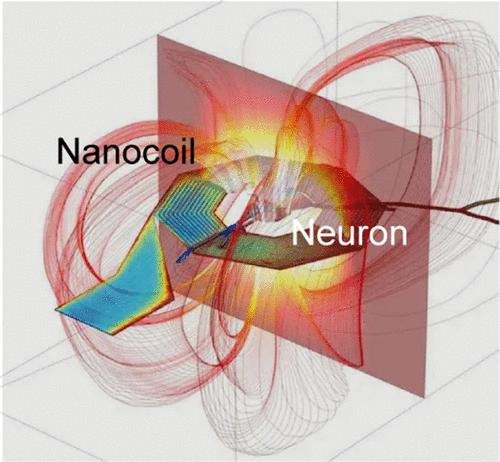利用纳米线圈传感器对神经活动进行磁探测
IF 11.3
1区 化学
Q1 CHEMISTRY, PHYSICAL
引用次数: 0
摘要
利用植入电极对脑细胞进行电生理记录是一项常规工作,但传统上需要与大脑外部进行有线连接。一种完全无源的无线装置不需要机载电源进行主动传输,但仍能方便地进行远程检测,这将为大规模直接记录动作电位打开大门,并改变我们获取大脑信号的方式。我们介绍了一种纳米加工线圈,它能形成神经电磁结,产生高度增强的电生理学磁场转导。我们的研究表明,这种微米级装置可以利用室温超导量子干涉装置(SQUID)显微镜从线圈中心对神经元场进行远程磁场检测。此外,结合磁力测量法的时间锁定刺激显示了阈值行为,证实了该技术在无需导线或板载电源的情况下进行检测的可行性。这种策略可以利用脑磁图和磁共振成像对电生理学进行前所未有的检测。本文章由计算机程序翻译,如有差异,请以英文原文为准。

Magnetic Detection of Neural Activity by Nanocoil Transducers
Electrophysiological recordings from brain cells are performed routinely using implanted electrodes, but they traditionally require a wired connection to the outside of the brain. A completely passive, wireless device that does not require on-board power for active transmission but that still facilitates remote detection could open the door for mass-scale direct recording of action potentials and transform the way we acquire brain signals. We present a nanofabricated coil that forms a neuroelectromagnetic junction, yielding a highly enhanced magnetic field transduction of electrophysiology. We show that this micrometer-scale device enables remote magnetic detection of neuronal fields from the center of the coil using room temperature superconducting quantum interference device (SQUID) microscopy. Further, time-locked stimulation in conjunction with magnetometry demonstrates thresholding behavior that affirms the viability of the technology for detection with no requirement for wires or on-board power. This strategy may permit unprecedented detection of electrophysiology using magnetoencephalography and magnetic resonance imaging.
求助全文
通过发布文献求助,成功后即可免费获取论文全文。
去求助
来源期刊

ACS Catalysis
CHEMISTRY, PHYSICAL-
CiteScore
20.80
自引率
6.20%
发文量
1253
审稿时长
1.5 months
期刊介绍:
ACS Catalysis is an esteemed journal that publishes original research in the fields of heterogeneous catalysis, molecular catalysis, and biocatalysis. It offers broad coverage across diverse areas such as life sciences, organometallics and synthesis, photochemistry and electrochemistry, drug discovery and synthesis, materials science, environmental protection, polymer discovery and synthesis, and energy and fuels.
The scope of the journal is to showcase innovative work in various aspects of catalysis. This includes new reactions and novel synthetic approaches utilizing known catalysts, the discovery or modification of new catalysts, elucidation of catalytic mechanisms through cutting-edge investigations, practical enhancements of existing processes, as well as conceptual advances in the field. Contributions to ACS Catalysis can encompass both experimental and theoretical research focused on catalytic molecules, macromolecules, and materials that exhibit catalytic turnover.
 求助内容:
求助内容: 应助结果提醒方式:
应助结果提醒方式:


